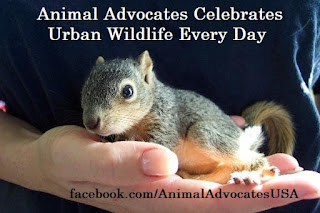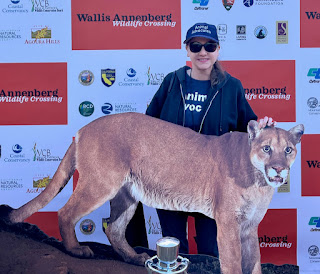Curriculum Vitae
Cummins is a bilingual Latina who grew up in a wildlife area of Los Angeles, California rescuing baby bunnies, squirrels and even a fawn by the age of six. She continued to rescue all types of animals on her own, with other organizations and for local animal shelters.
Cummins founded Animal Advocates an IRS recognized 501 3c non-profit organization in 2002. Animal Advocates is a registered California Corporation and legal charity with the California Attorney General. Cummins is a licensed wildlife rehabilitator specializing in small mammals including but not limited to coyotes, bobcats, foxes, skunks, raccoons, opossums, squirrels and bats.
Animal Advocates is the only wildlife rehabilitation facility in the city of Los Angeles which is home to over 5,000,000 people spread over 500 square miles. To date (2021) we have rescued and rehabilitated 8,368 wild animals and 1,254 domestic for a grand total of 9,622 animals. We provide wildlife education in English and Spanish in the community and through our work with the local, state and federal government. 2022 was our 20 year anniversary.
Education
• 1982 Beverly Hills High School, Dean's list, Swim team, Water Polo
• 1984 University of Southern California, Dean's list, Swim Team, Marks International Hall, Scholarship
Professional Education
• 1982 Emergency Medical Technician I
• 2001 Wildlife Paramedic I Basic training for wildlife emergency response
• 2003 IWRC Basic rehabilitation skills seminar, two day course, 13 hours
• 2004 Opossum Society, Opossum rehabilitation
• 2004 HSUS Animal Care two day seminar in Reno, Nevada
• 2005 Rio Hondo Police Academy PAC 43.76 PC 832 Arrest - Modules 1 & III
• 2005 Rio Hondo Police Academy PAC 43.77 PC 832 Firearms - Module II
• 2005 Animal Law Enforcement Academy, San Diego Humane Society and SPCA. 80 hours of approved credit by CVMA, sponsored by the State Humane Association of California to become a Humane Officer
• 2005 American Humane Association, Euthanasia by Injection Certificate, Pasadena Shelter
• 2005 American Humane Association - TV & Film, “No animals were harmed” one week training program. Employed in 2005.
• 2006 Pasadena Police Department Certificate of training Tazer X26
• 2005 LA Animal Services, Mitigating animal related injuries in the shelter environment
• 2005 LA Animal Services, Reptile care and handling
• 2005 LA Animal Services, Horse care and handling
• 2005 LA Animal Services, Wildlife care and handling
• 2010 Desert Studies Center, Southwestern bats, research techniques, Dr. Patricia Brown-Berry, 42 years of experience with bats
• 2011 Humane Society University, Animal First Aid for Disaster Responders, 8 hours live
• 2017 Animal Legal Defense Fund's Animal Law Summer School - Ag-Gag, Professor Alan Chen, University of Denver Sturm College of Law
• 2017 Animal Legal Defense Fund's Animal Law Summer School - Captive Wildlife, Matthew Liebman, Director of Litigation for the Animal Legal Defense Fund
• 2018 Big Cats in the City: Ecology, Behavior and Conservation of Mountain Lions around Los Angeles. Seth Riley.
• 2018 Animal Legal Defense Fund’s Animal Law School “Case Study: Elephants at the LA Zoo" presented by lawyer David Casselman.
• 2018 Wild Futures “Living with Mountain Lions in the Bay Area & Greater California.”
• 2019 Animal Legal Defense Fund’s “The Link between Violence against Humans and Animals.”
• 2020 IWRC, Coffee & Tea discussion on Cultivating anti-racism in wildlife rehabilitation
• 2021 New York City AAZK, Compassion Fatigue, Burnout, and the Zoological Field
• 2021 Beneath the Surface: Examining Triggers of Harmful Algal Blooms, Marine Mammal Care
• 2021 Prairie Dogs in Peril Zoom, James Trever of Prairie Dog Pals
• 2022 Groundbreaking of Wallis Annenberg Wildlife Crossing
• 2022 Post Human Infrastructure, Lauren Bon, Metabolic Studios
• 2022 Wildlife 2 Watts Educational Event
• 2022 Wallis Annenberg Wildlife Crossing Open House
• 2023 Latino Conservation Week programs
• 2023 Celebration of Life Event P22
• 2023 Natural History Museum P22 Museum Educational Visit
• 2023 IWRC Pinniped Control-Meeting Community Needs in a Time of Crisis
• 2023 Cougar Conservancy National Wildlife Federation Wallis Annenberg Wildlife Crossing Tour
• 2024 IWRC Wildlife Rehabilitation & Conservation in Rwanda
• 2024 IWRC Connections U Networking in Latin America, Spanish/English
• 2024 Animal Tracks Wildlife Sanctuary Educational Visit
• 2024 Recognizing and Understanding Bias for the Animal Welfare Professional
• 2024 IWRC International Wildlife Rehabilitation Council Coffee & Tea: A big problem with little animals: how insect declines may affect wildlife
Professional licenses, permits past and present
• 2001 Los Angeles City Gun Permit
• 2003 Los Angeles City Wildlife Permit
• 2003 USDA Class C Exhibitor Permit for Sanctuary animals
• 2004 CA Department of Fish and Wildlife trapping permit
• 2004 CA Department of Fish and Wildlife, Wildlife Rehabilitation permit, Educational Animals and later exhibit permit
Awards and acknowledgments
• 2003 EARS, Certificate of appreciation for assisting in the wildfires
• 2003 City of Los Angeles, Certificate of appreciation
• 2009 LA Animal Services, Certificate of appreciation
• 2010 Classy, Nonprofit Award
• 2013 Great Nonprofits, Top-Rated Nonprofit Award 3
• 2013 Los Angeles Business Journal, Corporate Citizen and Nonprofit
Selected media, publications, articles
• 2002 "What to do when you find a baby squirrel"
• 2002 "What to do when you find an injured squirrel"
• 2003 "How to reunite squirrels babies with their mothers"
• 2003 "How to trim trees with wildlife in mind"
• 2003 "How to properly care for un-releasable squirrels"
• 2003 "How to build proper caging for wildlife"
• 2003 Cat Fancy Magazine, "Mama Mia"
• 2003 "How to humanely deal with coyotes"
• 2004 "Rehabilitation of tree squirrels" manual.
• 2004 "Rehabilitation of ground squirrels" manual.
• 2004 "Rehabilitation of skunks" manual.
• 2004 "Treatment of Malocclusion in Squirrels," Co-author Dr. Bill Ridgeway
• 2004 "How to trim rodent teeth"
• 2004 "How to make pet squirrels wild again"
• 2004 "How to set up a wildlife referral system in animal shelters"
• 2005 IWRC, "Journal of Wildlife Rehabilitation," "Raising baby tree squirrels from weaning to release"
• 2000-2024 Over 500 wildlife, animal articles written for blogs, newspapers, online media and others Selected media
• 2003 Animal Planet "Beverly Hills Vet, Squirrel Rehabilitation"
• 2003 CADFG "Scrawl of the Wild"
• 2003 LA Times "Rodent poisoning project angers animal activists"
• 2004 Cable television show "Wildlife Rescue," six episodes, Doggy TV
• 2004 Gardena Valley News "Helping furry friends survive urban jungle"
• 2004 KROQ radio interview with Scott Mason
• 2005 Discovery Channel "The Undetectables, Squirrel Care"
• 2005 LA Weekly "A Billionaire's Bark"
• 2005 KROQ radio interview with Scott Mason
• 2005 Thousand Oaks Acorn “Public outcry over slain tiger loud—but not universal”
• 2005 LA Times "Urban remedies: Dealing with new arrivals"
• 2005 Thousand Oaks Acorn "Public outcry over slain tiger loud-but not universal"
• 2005 LA City Beat "Welcome to the jungle"
• 2006 Daily News "Stuckey stays on as $50,000 City consultant"
• 2006 Book "Squirrels: The Animal Answer Guide"
• 2006 Daily News "County relaxes restrictions on llamas, animal rehab"
• 2006 Daily News "Council hears Stuckey critics"
• 2006 LA Times "Fired City Official's appeal in limbo"
• 2007 LA Times "Opossums: your garden's evening clean-up crew"
• 2009 LA Times "Your morning adorable, baby skunks and the handstand dance"
• 2010 Martha Stewart "A gopher named Charlie"
• 2010 Martha Stewart "A second chance for Charlie"
• 2010 LA Times "Your morning adorable: rescued rabbit enjoys a meal"
• 2010 LA Times "Your morning adorable: rub a dub dub, raccoons in a tub"
• 2010 Top YouTube pets video channel in March
• 2011 Ventura County Star “City says bats remain at Moorpark home”
• 2011 CBS Los Angeles “Moorpark Says Homeowners Not Doing Enough To Fight Bats”
• 2011 NBC “WeHo one step closer to fur ban”
• 2012 Santa Monica Patch “Wild Animal in Town? Call on Us, Vet Says”
• 2012 Santa Monica Daily Press “Groups want policy change after mountain lion death”
• 2012 ABC “IDA Rally held in Santa Monica in protest of fatal shooting of mountain lion”
• 2012 NBC “Animal-Rights Group Protests Santa Monica Mountain Lion Shooting”
• 2012 Member of Santa Monica City after incident report in regard to mountain lion shooting
Social Media
• Over 78,000 Facebook fans
• Over 8,000 YouTube subscribers
• Over 12,000,000 YouTube video views
• Over 99,000 YouTube watch hours
• Approved Member Facebook/Meta Nonprofit Growth Program
Experience
• 2001- Present Wildlife rehabilitation. Rescued over 8,000 wild animals with a release rate over 90%
• 2001- Present Wildlife education, presentations to Oasis, Crossroads school, LA Animal Services, Best Friends super adoption, Temple Beth El private school and many others
• 2001- 2006 LA Animal Services, animal shelter volunteer
• 2003 Dept of Fish & Wildlife cleanup of Tiger Rescue, Chuck Traisi, volunteer
• 2003 City of Buena Ventura no-feed plan for wildlife
• 2004 New wildlife policy approved in Los Angeles City
• 2005 American Humane Association - TV & Film, “No animals were harmed” team
• 2006 Amendment to LA County zoning which allows wildlife rehabilitation
• 2006 Redid the LA Animal Services website, added "Adopt a Pet" feature
• 2006 Birth control program for squirrels in Santa Monica
• 2006 Assistant to Director of Found Animals Foundation
• 2010 HSUS NDART team cockfight raid Nipomo, CA
• 2011 HSUS NDART team 150 dog rescue Lucerne Valley, CA
• 2012 City of Santa Monica Mountain Lion Task Force with IDA
• 2013 Expert Opossum Witness for PETA for opossum lawsuit
• 2013 Expert Animal Cruelty Presentation for Animal Defense League Animal Law School
• 2013 Presentation for California Attorney General “We Love Wildlife!” Campaign
• 2020 A Critical Evaluation of Legal and Illegal Killing of Native Predators, Dr. Adrian Treves
• 2024 Bat Roost Count Natural History Museum of Los Angeles
• 2024 International Wildlife Rehabilitation Council IWRC Connections and Networking in Latin America and the Caribbean
• 2024 72nd Annual Wildlife Disease Association conference by WDA Australia
• 2025 Howliday Clinic for Pets Experiencing Homelessness with K9 Connection, Pets Laneding, Street Dog Coalition
• 2025 Rescued and Sheltered Animals Displaced by Los Angeles Fires
• 2025 Ballona Wetlands Ecological Reserve
• 2025 Blessing of the Animals Los Angeles
Committees/Task forces
• 2004 LA Animal Services Spanish language Committee, Spay and Neuter Committee, Wildlife Committee, Adopt-a-thon Committee, New Hope Partner
• 2005 LA City, Councilman Zine Coyote Task Force
• 2005 Approved by Mayor to be a commissioner for LA Animal Services
• 2006 LA City Proposition F Committee
• 2008 Humane Society of the United States (HSUS) National Disaster Animal Response Team (NDART)
• 2012 Santa Monica Police, Animal Control, Fish & Wildlife After Mountain Lion Killing Incident Task Force
• 2012 Santa Monica Police, Animal Control, Fish & Wildlife After Mountain Lion Killing Incident Task Force
Professional memberships
• California Council for Wildlife Rehabilitators
• National Wildlife Rehabilitation Association
• International Wildlife Rehabilitation Council
Facebook https://www.facebook.com/AnimalAdvocatesUSA
LinkedIn https://www.linkedin.com/company/animal-advocates
YouTube https://www.youtube.com/@MaryCummins
Instagram https://www.instagram.com/animaladvocatesusa/
Blog https://animaladvocatesmarycummins.blogspot.com/
#marycummins #animaladvocates #curriculumvitae #resume #wildliferehabilitation #wildliferehabilitator #wildliferescue #squirrels #skunks #opossums #raccoons #bats #bobcats #coyotes #gophers #chipmunks #losangeles #california #animaladvocatesus
- Mary Cummins LinkedIn
- Mary Cummins Meet up
- Animal Advocates custom Facebook name
- Mary Cummins Real Estate blog
- Animal Advocates on Google maps
- Mary Cummins of Animal Advocates
- Mary Cummins biography resume short
- Mary Cummins Real Estate Services
- Animal Advocates fan page at Facebook.com
- Mary Cummins Animal Advocates Squirrel Rescue
- Mary Cummins Animal Advocates on Flickr photos
- Mary Cummins Animal Advocates on Twitter.com
- Mary Cummins on Picasa web photo albums
- Mary Cummins on MySpace.com
- Mary Cummins on Google Blogger Blogspot
- Mary Cummins on YouTube.com videos
- Mary Cummins of Animal Advocates on Classmates
- Mary Cummins on VK
- Mary Cummins of Animal Advocates on Google+




























